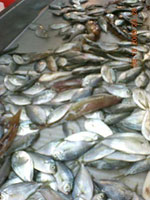

 | |||||||||||||
|
|
Journals 2009/2010Beth Brocato
September 19, 2009 The ship is making its way north and a bit closer to shore as we continue to sample the local fish species. As we make our way farther north, the species diversity has greatly diminished. We are seeing a lot of scup, spot, butterfish and hake.
Also, we happen to be catching a lot of very large rays. Both stingrays and butterfly rays are present in almost every tow. They are so big they have to be weighed on the deck of the ship with a crane. One of the science crew must de-barb the stingray before anyone else can handle it. They can be quite dangerous. Smaller rays are brought into the lab to be processed.
The other "greenhorns" and I are just finding out that the trip down was just practice for the rapid pace of the stations on the way back. Today we had a full catch waiting for us when we got to the lab at midnight. After that the stations came back to back. Just as we were processing one catch, another was waiting in the hopper. Aw, my aching back! Apparently the next four days will be just like this. Aside from a half-hour break for breakfast at 7 a.m., I think we had a total of 1 hour of down time in this 12 hour shift. Just enough time to see the sunrise.
|
||||||||||||


